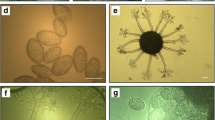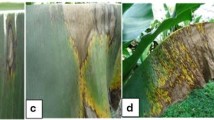Abstract
Stem rot and wilt of Jew’s marrow (nalta jute, Corchorus olitorius) were found on Is. Okinawa, Okinawa Prefecture, Japan, in March 2000. An anamorphic fungus, Lasiodiplodia theobromae was isolated repeatedly from the diseased plants and demonstrated to cause the disease. We coined the Japanese name “kurogare-byô” of Jew’s marrow for the present disease because it was new to Japan, although it had already been reported in India and Bangladesh as black band of the plant.

Similar content being viewed by others
References
Haque MA, Chowdhury SNA, Ahmed QA (1973) Physiologic specialization in Botryodiplodia theobromae, the causal organism of black band disease of jute, Corchorus species. Bangladesh J Bot 2:83–92
Holliday P (1980) Botryodiplodia theobromae. In: Holliday P (ed) Fungus diseases of tropical crops, Cambridge University Press, Cambridge, pp 42–44
Hoshikawa K (1989) Corchorus L. In: Hotta M, Ogata K, Nitta A, Hoshikawa K, Yanagi M, Yamazaki K (eds) Useful plants of the world (in Japanese). Heibonsha, Tokyo, p 313
Mukerjee N, Mishra CBP (1988) Diseases of jute and their management. Rev Trop Pl Path 5:255–271
Nago H, Matsumoto M (1994) An ecological role of volatiles produced by Lasiodiplodia theobromae. Biosci Biotech Biochem 58:1267–1272
Phytopathological Society of Japan (2000) Jew’s marrow. In: Phytopathological Society of Japan (ed) Common names of plant diseases in Japan (in Japanese), Japan Plant Protection Association, Tokyo, p 257
Punithalingam E (1980) 8. Fibre plants (a) Jute (Corchorus spp.). In: Pnithalingam E (ed) Plant diseases attributed to Botryodiplodia theobromae Pat.1980, pp 29–31
Sato T, Iwamoto Y, Tomioka K, Takaesu K (2002) Black band of Jew’s marrow (Corchorus olitorius), trunk rot of satsuma mandarin (Citrus unshiu) and screw-pine (Pandanus boninensis) fruit-rot caused by Lasiodiplodia theobromae (abstract in Japanese). Jpn J Phytopathol 68:186
Shaw FJF (1921) Studies in diseases of the jute plant. Mem Dept Agric India (Bot Ser) 11:37–58
Sutton BC (1980) Lasiodiplodia Ell. and Ev. apud Clendenin. In: Sutton BC (ed) The coelomycetes. Fungi imperfecti with pycnidia, acervuli and stromata. Commonwealth Mycological Institute, Kew, p 191
Sydow H, Sydow P, Butler EJ (1916) Fungi Indiae orientalis. Annal Mycol 14:196
Takushi T, Takaesu K, Taba S, Moromizato Z (2000) Stem-end rot of mango caused by Lasiodiplodia theobromae (abstract in Japanese). Jpn J Phytopathol 66:99–100
Wadud MA, Ahmed QA (1962) Studies on fungous organisms associated with wilted jute plants. Mycopath Mycol Appl 18:107–114
Weber GF (1973) Jute. In: Weber GF (ed) Bacterial and fungal diseases of plants in the tropics. University of Florida Press, Gainesville, pp 302–304
Author information
Authors and Affiliations
Corresponding author
Rights and permissions
About this article
Cite this article
Sato, T., Iwamoto, Y., Tomioka, K. et al. Black band of Jew’s marrow caused by Lasiodiplodia theobromae . J Gen Plant Pathol 74, 91–93 (2008). https://doi.org/10.1007/s10327-007-0056-2
Received:
Accepted:
Published:
Issue Date:
DOI: https://doi.org/10.1007/s10327-007-0056-2




